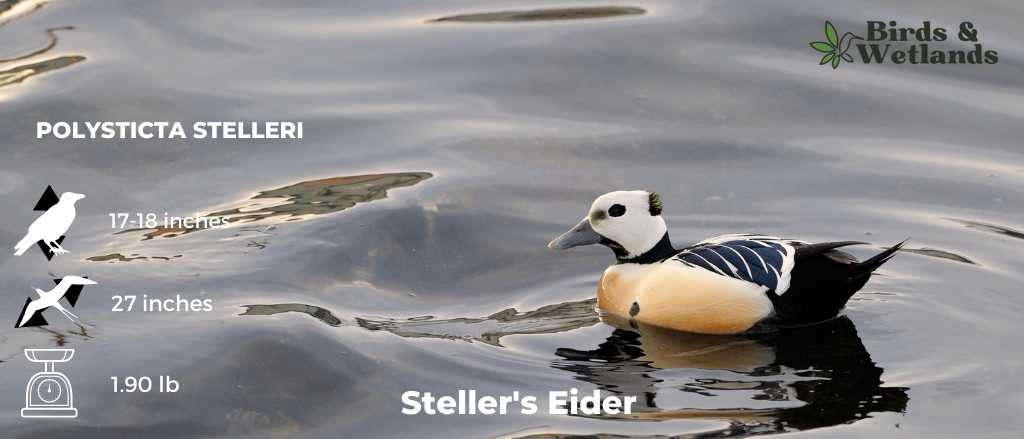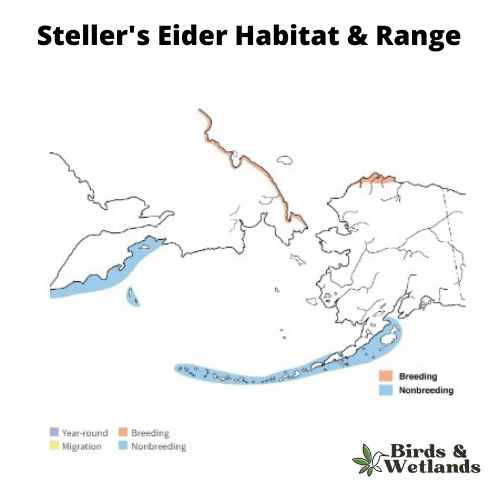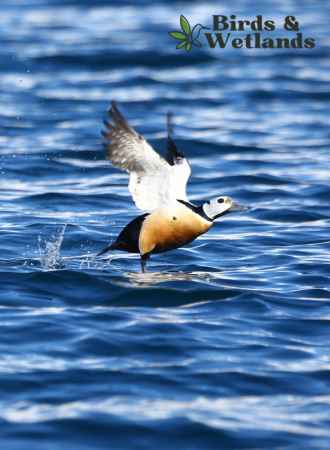
The Steller’s eider (Polysticta stelleri) is a small, compact sea duck with a large head and black eye spot that breeds in the Arctic regions of Russia, northern Alaska, and Canada. It is named after the naturalist Georg Wilhelm Steller, who first described the species in the 18th century.
The Steller’s eider is the rarest and smallest of the eider species, a group of sea ducks that includes the common eider, king eider, and spectacled eider.
In 1997, the Steller’s eider was added to the vulnerable species list of the International Union for Conservation of Nature (IUCN) due to declining population numbers.
Scientific Name: Polysticta stelleri
Height: 430–460 mm (17–18 in)
Wingspan: 690 mm (27 in)
Weight: 860 g (1.90 lb)
Taxonomy
The Steller’s eider is the only species in the genus Polysticta and differs from other eiders in its behavior and anatomy. It belongs to the family Anatidae, which includes other ducks, geese, and swans. The decision to separate this species into its own genus was made by scientists in 1945.
Physical Description
The Steller’s eider is the smallest of the four eider species.
Male
The adult male Steller’s eider is a distinctive bird with a white head and greenish feathers on the lores and nape. It has a black eyering, chin, and throat, blue-gray feet and a long tail. Its upper parts are white on the sides of the mantle and fore part of the scapulars and marked with purple on the tertials and rear part of the scapulars.

Female
The adult female Steller’s eider is a beautiful bird with a rich dark brown to cinnamon-colored body, rufous-brown head with pale buff eyering, reddish-brown wings featuring a dull speculum (secondary feathers) with a white border, white underwings and broad white tips on the primaries and secondaries.
Listen to the Steller’s Eider
Distribution & Breeding Range

Steller’s eiders are a sea duck species that breed in the Arctic regions of Arctic Russia and Alaska. There are three recognized breeding populations of Steller’s eiders: the Russian-Atlantic population, the Russian-Pacific population, and the Alaska-breeding population.
The Russian-Atlantic breeding population breeds west of the Khatanga River in western Siberia and winters in the Barents and Baltic seas. This population winters in northern Europe.
The Russian-Pacific population nests on the east side of the Khatanga River and spends its winters in the southern Bering Sea and the northern Pacific Ocean. This population winters in eastern Russia and some flocks may travel as far as the Aleutian Islands.
The Alaska-breeding population is the smallest of the three, with less than 1% of the global population nesting in the Alaska Peninsula. These eiders nest on the Arctic Coastal Plain and, in rare cases, the Yukon-Kuskokwim Delta, and winter in the southern Bering Sea and the northern Pacific Ocean.
Habitat
The Steller’s eider breeds in the Arctic tundra regions of Alaska, Canada, and Russia. It prefers to nest near shallow pools, ponds, lakes, and rivers in coastal areas. These areas provide the eider with a reliable food source, such as small fish and invertebrates, which it feeds on during the breeding season.
Its breeding habitats include open tundra with low-lying vegetation, such as grasses, mosses, and lichens.
During the winter months, the Steller’s eider forms large flocks and can be seen on rocky coasts, in bays, and estuaries. It typically occurs in areas of very shallow water, where it can find food, such as small fish, crustaceans, polychaete worms and mollusks.
The eider’s winter habitat is often characterized by rocky shores, tidal flats, and sandbars, which shelter the bird from the elements and predators.
Feeding Habits & Diet

On the breeding grounds, Steller’s Eiders feed on a variety of items, including insect larvae, small crustaceans, aquatic insects and seeds of grasses and pondweed. They primarily forage by dabbling or submerging their head and breast underwater like a dabbling duck to reach prey in shallow ponds.
During the rest of the year, their diet consists mostly of mollusks and small crustaceans, but it also includes marine worms, sand dollars, and brachiopods.
At their stopover sites and wintering grounds, they forage in beds of eelgrass and seaweed, where they find a variety of prey, including mollusks, marine worms, and tiny crustaceans. They may also consume foraminifera. When foraging in deeper water, they dive and pursue prey while swimming, using their wings and feet to maneuver.
Steller’s Eiders have diverse feeding behavior, including dabbling, tipping up, and swimming underwater to catch prey. They may forage in large flocks, diving in unison and creating a spray as they surface.
During molting season, they tend to consume more mussels, but once their new feathers have grown in, they shift to consuming more amphipods and tiny clams.
Nesting & Mating Habits
Steller’s eiders gather in tundra lakes, small ponds and lagoon systems during the breeding season.
Pairs form in the winter, with the breeding season starting in late June and lasting until August. Before pairs are formed, adult males engage in elaborate displays during courtship, such as preening, calling, and displaying their feathers to attract egg-laying females. Several males may court one female.
Steller’s eiders are solitary nesters, but some females may nest in loose colonies, with females choosing the nest site and constructing the nest. Nesting sites are typically located on the ground, often near the water’s edge or on small islands.
Nests are made of grass, moss, lichen and other plant material and are lined with down feathers to keep eggs warm.
Clutch size for Steller’s eiders varies but typically consists of 3-8 olive-buff eggs. Females incubate alone for 25 to 30 days. During this time, the male may stay and guard the female, but he will depart once all eggs hatch to join other males at their molting sites.
Upon hatching, young Steller’s eiders are covered in down and can swim and dive within a few days. The female keeps her young close to the nest until they are fully fledged at 45 to 50 days.
Once young Steller’s eiders learn how to fly, they will join other birds with their mothers to form flocks at their molting sites.
Threats & Conservation

The Steller’s eider is currently evaluated as “Vulnerable” by the IUCN. Additionally, the Alaskan population was listed under the Endangered Species Act by the U.S. Fish and Wildlife Service in 1997.
This duck faces numerous threats in the wild, including habitat loss due to climate change and natural resource exploitation, lead poisoning and predation of Steller’s eider eggs and ducklings.
Conservationists are currently advocating for the permanent protection of the critical habitat of the Steller’s eider and other wildlife around the Arctic National Wildlife Refuge, which was opened for oil and gas exploration in 2017.
The Alaska Department of Fish and Gam and Fairbanks Fish and Wildlife Field Office are monitoring nesting populations of Steller’s and spectacled eiders in Barrow, Alaska and some parts of western Alaska.
Hunting
Steller’s eider hunting was made illegal in 1991 due to the species’ declining population.
Key Points
- The Steller’s eiders mainly eat aquatic invertebrates but will occasionally eat aquatic plants.
- It is the smallest and rarest compared to other eider species.
- Steller’s eiders spend winters along coastal bays with other diving ducks, such as the Harlequin duck.

